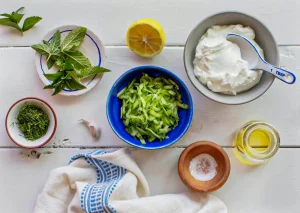If you’ve ever had the pleasure of dining on Mediterranean food, you know that tzatziki is one of those essential sauces that elevate any dish it touches.
Its cool, creamy texture and fresh, zesty flavors make it the perfect accompaniment to everything from grilled meats to crunchy veggies. Tzatziki is more than just a dip or a sauce; it’s an experience.
Its origins trace back to Greece and Turkey, but it has since become a beloved dish throughout the Mediterranean.
But, while store-bought tzatziki can be a convenient option, it’s never quite as fresh or flavorful as the homemade version. Homemade tzatziki allows you to control the ingredients, making sure it’s as creamy, garlicky, and herbaceous as you like it.
Plus, there’s something incredibly satisfying about preparing your own sauce, especially when it comes together so easily and with such few ingredients.
This homemade tzatziki recipe is one you’ll turn to again and again, whether for a light summer snack, a refreshing topping for grilled meats, or as a dip for your next Mediterranean spread.
Let’s dive in!
The Origins of Tzatziki
Tzatziki is a staple of Mediterranean cuisine, particularly in Greece, Turkey, and the surrounding regions. While the dish has evolved over centuries, its base ingredients remain the same: yogurt, cucumber, garlic, and olive oil.
This combination results in a refreshing and cooling sauce that perfectly complements the rich, smoky flavors of grilled meats, falafel, and roasted vegetables.
In Greek cuisine, tzatziki is traditionally served alongside gyros or souvlaki, offering a refreshing contrast to the spicy and savory meats.
In Turkey, it’s known as Cacık, which is similar but often thinned out and served as a drink. No matter where you enjoy it, tzatziki is a testament to the Mediterranean’s ability to create simple yet flavorful dishes with just a few high-quality ingredients.
Why Homemade Tzatziki is Worth the Effort
You might be wondering—why bother making tzatziki at home when you can find it pre-made at the store? Here’s the thing: homemade tzatziki is far superior to the store-bought variety in both flavor and texture.
While store-bought versions can be overly salty or watery, homemade tzatziki allows you to control the balance of flavors and the thickness of the sauce.
Not to mention, making it yourself is so much easier than you might think. It’s a quick recipe that takes less than 10 minutes to prepare, yet it tastes so much fresher and more vibrant.
By using high-quality ingredients and fresh herbs, you can craft a tzatziki that will leave store-bought versions in the dust.
What You’ll Need for a Perfect Tzatziki
Ingredients:
To make the perfect tzatziki, you don’t need a long list of ingredients—just a few key items that bring this classic Mediterranean dish to life. Let’s break it down:
Essential Ingredients:
- Greek Yogurt: Greek yogurt is the foundation of tzatziki and gives the sauce its rich, creamy texture. Look for full-fat, plain Greek yogurt for the best consistency and flavor.
- Cucumber: Fresh cucumbers provide the crunch and refreshing taste that tzatziki is known for. Grate them finely and drain them to avoid making the sauce too watery.
- Garlic: Fresh garlic adds the bold, aromatic kick that balances the coolness of the yogurt and cucumber.
- Olive Oil: A good extra-virgin olive oil is a must for the richness and depth of flavor it brings to the sauce.
- Lemon Juice: A little squeeze of lemon juice adds brightness and a touch of acidity, rounding out the flavors.
- Salt: A pinch of salt helps combine all the ingredients and enhances the sauce’s natural flavors.
Optional Ingredients:
- Fresh Herbs: Dill and mint are traditional herbs used in tzatziki, adding a burst of freshness and flavor. You can also experiment with other herbs, like parsley, to suit your taste.
- Vinegar: Some recipes call for a small splash of vinegar in addition to lemon juice, which can add an extra layer of tanginess. This is optional depending on your taste preferences.
Quality Tips:
- For the best tzatziki, always opt for high-quality Greek yogurt. Its thick texture is what gives the sauce its luxurious feel. Avoid low-fat or non-fat yogurt, as it may lack the necessary creaminess.
- Choose a crisp cucumber with a firm texture. Watery cucumbers can make the tzatziki too thin and dilute the flavors.
Preparation Steps: Making Tzatziki at Home
Making tzatziki from scratch is as easy as mixing a few ingredients, but there are a few key steps to get the texture right. Let’s walk through the process:
Step 1: Grate and Drain the Cucumber
Start by grating the cucumber using the largest holes on a box grater. This will give your tzatziki a nice texture with flecks of green throughout.
After grating, place the cucumber in a clean kitchen towel or cheesecloth and squeeze out as much excess water as possible. This step is essential because any leftover moisture will water down the sauce and make it runny.
Step 2: Mix the Ingredients
In a medium mixing bowl, combine the grated cucumber, Greek yogurt, minced garlic, olive oil, lemon juice, salt, and herbs. Stir well to combine until you have a smooth, creamy sauce.
Taste and adjust the seasoning if needed, adding more garlic, salt, or lemon juice to suit your preferences.
Step 3: Chill and Serve
Tzatziki benefits from a bit of chill time in the fridge, so let it rest for at least 30 minutes before serving.
This gives the flavors time to meld together and creates a better overall taste.
Serving Ideas: How to Enjoy Your Homemade Tzatziki
Tzatziki is one of the most versatile condiments you can have on hand. Here are some delicious ways to serve it:
- Classic Greek Style: Serve it alongside gyros, souvlaki, or grilled lamb for a traditional Mediterranean feast.
- As a Dip: Tzatziki is perfect as a dip for pita bread, fresh vegetables, or crispy crackers. It’s the perfect snack for a Mediterranean-themed appetizer spread.
- With Grilled Meats: Drizzle tzatziki over grilled chicken, beef kebabs, or falafel for a light, refreshing contrast to the smoky, savory flavors.
- On Sandwiches: Use tzatziki as a sauce on wraps or sandwiches, such as a chicken wrap, falafel pita, or veggie burger.
- With Salad: To add a cool and creamy element, try tzatziki as a dressing on a Greek salad or as a topping for tabbouleh.
Key Notes
- Course: Appetizer
- Cuisine: Mediterranean
- Keywords: Tzatziki Recipe, Homemade Tzatziki, Greek Tzatziki, Tzatziki Sauce, Mediterranean Sauce, Fresh Tzatziki, Vegan Tzatziki, Easy Tzatziki
- Prep Time: 10 minutes
- Cook Time: 0 minutes
- Total Time: 10 minutes
- Servings: 4-6 servings
- Calories: 100 per serving
Customization Options:
Tzatziki is a highly customizable sauce, so don’t hesitate to get creative and adjust it to your liking.
Add Fresh Herbs
- Dill is the classic herb for tzatziki, providing a fresh, slightly tangy flavor.
- Mint adds a cooling note, which is especially refreshing in summer. You can add one or both depending on your preference.
- For a slightly different twist, consider adding oregano or parsley for extra Mediterranean flair.
Adjust the Flavor
- If you like your tzatziki with a stronger garlic punch, feel free to add more minced garlic.
- Lemon zest is a great way to amplify the citrus flavor and add an extra layer of freshness.
Dairy-Free and Vegan Tzatziki
If you’re following a dairy-free or vegan lifestyle, swapping out the yogurt for plant-based options is easy. For the closest texture and flavor, use vegan Greek-style yogurt made from coconut or almonds. Alternatively, you can try a cashew-based tzatziki, which is rich, creamy, and equally satisfying.
Fresh, Simple, and Versatile—Tzatziki is a Must-Make
Homemade tzatziki is one of those recipes that brings a taste of the Mediterranean into your home with minimal effort. You can create a fresh, creamy, and zesty sauce that will elevate any meal with just a few high-quality ingredients.
Whether you’re enjoying it as a dip, using it as a topping for grilled meats, or adding it to salads and sandwiches, tzatziki is a versatile condiment that’s perfect for any occasion.
I hope you’ll give this recipe a try! It’s easy, quick, and bursting with fresh flavors that will have your taste buds dancing.
Don’t be afraid to experiment with different herbs and seasonings, and be sure to share your creations. I’d love to hear how you made this recipe your own.
What’s your favorite way to enjoy tzatziki? Drop a comment below and share your thoughts!
Frequently Asked Questions (FAQ)
1. Is tzatziki gluten-free?
Yes! Tzatziki is naturally gluten-free, but if you’re serving it with pita or crackers, ensure they are labeled gluten-free.
2. How long does homemade tzatziki last in the fridge?
When stored in an airtight container, homemade tzatziki will stay fresh in the fridge for up to 3-4 days. For the best texture and flavor, enjoy it within that time.
3. Can I make tzatziki ahead of time?
Yes! Tzatziki tastes even better when allowed to sit for a few hours or overnight in the fridge, as it melts the flavors together.
4. How do I prevent tzatziki from becoming too watery?
Drain the grated cucumber well before mixing it with the yogurt to avoid watery tzatziki. Squeeze out excess moisture using a fine-mesh strainer or a kitchen towel.
5. Can I freeze tzatziki?
It’s not recommended to freeze tzatziki, as freezing can alter its texture and cause the yogurt to separate. If you must freeze it, store in an airtight container for up to 1 month. Thaw in the refrigerator overnight and stir before serving.
6. What are some creative ways to serve tzatziki?
- As a dip: Serve with pita, fresh veggies, or crackers.
- With grilled meats: Great with kebabs, grilled chicken, or lamb.
- On sandwiches or wraps: Perfect on gyros, shawarma, or falafel wraps.
- Mediterranean platter: Pair wit h falafel, hummus, or tabbouleh for a delightful spread.
7. How can I make my tzatziki spicier?
Add finely chopped jalapeños or a pinch of cayenne pepper for a spicier tzatziki. Adjust to your preferred level of heat.
Author
-
The Los Foodies Magazine content team is dedicated to showcasing New Mexico’s food culture through stories, recipes, events, and local business features. They create engaging content that connects readers with the chefs, restaurants, and flavors that define the community.
View all posts Los Foodies Magazine Content Team











